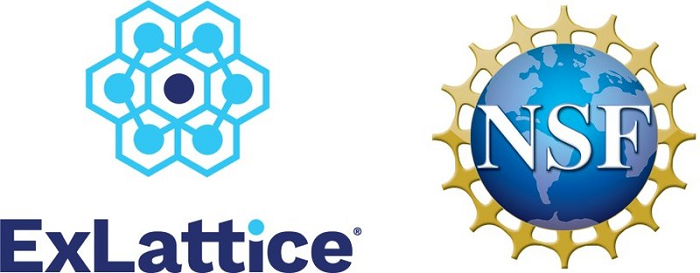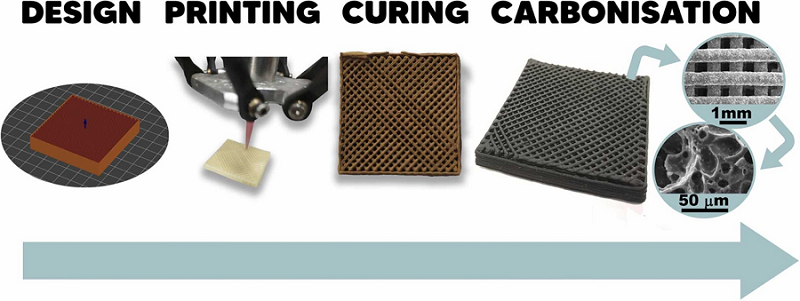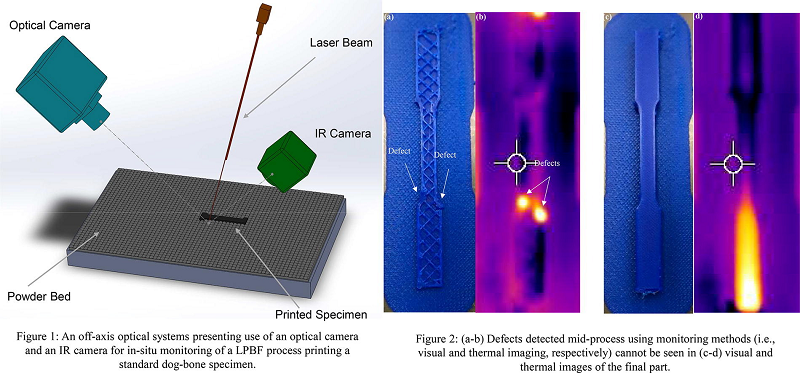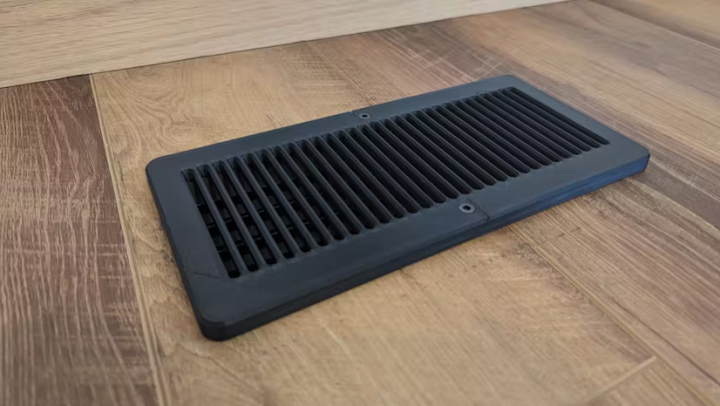We’re kicking things off with education in today’s 3D Printing News Briefs, after a recent “Girl Meets AM” program for high school students. Moving on to business, ExLattice has received an SBIR Phase I award from the National Science Foundation to speed up engineering simulation for AM. On the materials side of things, Desktop Metal has qualified two Loctite materials for use with the Xtreme 8K, and researchers are 3D printing porous carbon materials from dehydrated whey byproduct. Speaking of research, a team from NYU completed a review on in-situ monitoring of AM defects. Finally, a 3D printed smart vent gives homeowners total control of their HVAC system.
Girl Meets Additive Manufacturing Camp for High Schoolers
Recently, Intrepid Automation, which develops technology solutions for industrial manufacturing, partnered with 501(c)3 nonprofit Greater Than Tech (GTT) and Collins Aerospace to offer a free, four-day additive manufacturing summer camp at the University of San Diego. GTT works to immerse girls and underserved youth to business and STEM opportunities, and the Girl Meets AM camp, which was open to San Diego high school students, focused on topics like 3D printing, CAD modeling, cost-benefit analysis, DfAM, and engineering basics for industrial manufacturing. Engineering mentors were onsite, and girls had the opportunity to design, print, and test out their own parts, and on the final day of camp, they showcased their designs. The camp also provided food, swag bags, and transportation vouchers.
“Near and dear to my heart is being intentional with opportunities to open doors to young women of color to STEM and entrepreneurship. Collins Aerospace looks forward to continuing to create pathways such as this one to introduce and develop our future workforce,” said Stan Kottke, vice president and general manager of Aerostructures for Collins Aerospace.
ExLattice Receives $250,000 SBIR Award from NSF
Manufacturing AI company ExLattice, a software ventured founded in 2018 in North Carolina, announced that it received a Phase I award from the National Science Foundation (NSF) Small Business Innovation Research (SBIR) Program to continue developing its accelerated simulation engine for additive manufacturing. ExLattice will use the grant to develop and validate ultrafast manufacturing simulation solutions, together with several university partners. The overall goal is to reduce the lengthy steps in computation and deliver real-time engineering solutions so that users can better understand, control, and improve AM systems and outcomes. America’s Seed Fund, powered by NSF and its $8.8 billion budget, awards $200 million a year to small businesses and startups; the grant ExLattice received is valued at over $250,000.
“Receiving the SBIR award from NSF is another proof of our vision in engineering software for digital manufacturing. The NSF SBIR grant not only provides us the resources, but a platform to collaborate with leading experts in academia and great business partners in bringing AI to manufacturing,” said Dr. Runze Huang, CEO, ExLattice.
Desktop Metal Qualifies 2 Henkel Loctite Materials on Xtreme 8K
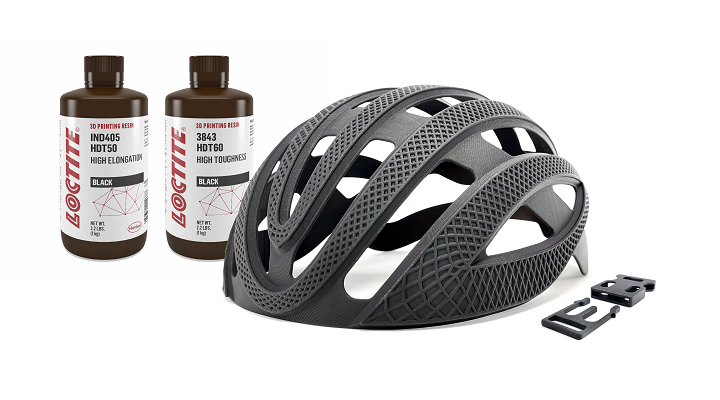
This bicycle helmet was 3D printed on the ETEC Xtreme 8K in Loctite 3D IND405™ Black while the clip was printed in Loctite 3D 3843. These two popular photopolymers, developed and produced by Henkel, are now qualified on the ETEC Xtreme 8K, the world’s largest DLP printer.
The current partnership between Desktop Metal, Inc. (NYSE: DM) and Henkel, revolving around photopolymer material development, is expanding, starting with qualifying Henkel’s popular Loctite 3D IND405 Black and Loctite 3D 3843 for use on the ETEC Xtreme 8K. The materials are both strong, stiff, and durable, with excellent surface finish, while parts printed in IND405 also feature outstanding impact resistance. They’re both already offered in the ETEC Envision One desktop DLP printer, but now they can be printed on the Xtreme 8K, which is the world’s largest DLP system for high-volume production of end-use parts, with a build area of 450 x 371 x 399 mm. Being able to print these trusted materials on the large, top-down DLP platform will make it possible for users to fabricate new sizes and throughputs of parts without resorting to expensive tooling.
“Our team is delighted to partner with Henkel and offer their Loctite materials on our truly differentiated DLP printing systems. By printing Loctite 3D IND405 HDT50 High Elongation and Loctite 3D 3843 HDT60 High Toughness on the ETEC Xtreme 8K, manufacturers will be able to produce on-demand end-use parts in all-new sizes and at higher throughputs that help drive down the per-part cost. What’s more, they won’t need to pay for, or wait for, tooling to get the job done affordably,” said Desktop Metal’s Founder and CEO Ric Fulop.
3D Printing Porous Carbon Structures from Partially Dehydrated Whey
3D printing has been used to produce activated carbons, but the thermoplastic materials that often use printed porous carbon precursors can lose their shape post-carbonization. Researchers from Instituto de Ciencia y Tecnología del Carbono (INCAR-CSIC), Universidad de Oviedo, and Instituto de Investigación Sanitaria del Principado de Asturias published a research paper demonstrating the feasibility of 3D printing porous carbon structures using partially dehydrated whey, which is a sustainable natural product that’s annually produced in large amounts by the global dairy industry. The researchers hand mixed different proportions of distilled water and whey powders to create 3D printable ink and paste, which was then used to easily print porous carbon structures like cylinders and prisms with lattice infill using robocasting.
A modified CERAMBOT Pro system, with a 20 Ga plastic nozzle, was used to print the structures at 0.6 mm layer height and 20 mm/s print speed, at 20-22 oC. The printed whey structures were dried and cured, then carbonized in a ceramic reactor, and several of these were demineralized to reduce their ash content. To characterize and investigate the properties of the 3D printed carbon structures, the researchers performed organic elemental analysis, thermogravimetric analyses, and field emission scanning electron microscopy-energy dispersive X-ray (FESEM-EDX) analyses. They found that it was feasible to use partially dehydrated whey as a carbon precursor to 3D print porous carbon structures using robocasting.
In-Situ Monitoring Review of Sub-Surface & Internal AM Defects
A pair of researchers from New York University Tandon School of Engineering published a paper that was a review about in-situ monitoring of sub-surface and internal defects in AM. 3D printing processes rely on a set of optimized parameters, set by the user, to create components, and real-time monitoring and control of these processes can create a closed-loop process that’s able to achieve repeatability and process stability by detecting and correction defects. By integrating machine learning and monitoring methods in the AM process, users can continually evaluate the quality of material deposition, and come up with more intervention methods to correct the defects in-situ. In this review, the researchers go over imaging and acoustic monitoring techniques that can track, analyze, and limit internal and sub-surface defects that occur during printing, such as simultaneous use of different imaging methods.
“Imaging methods consist of visual and thermal monitoring techniques, such as optical cameras, infrared (IR) cameras, and X-ray imaging. Many studies have been conducted that prove the reliability of imaging methods in monitoring the printing process and build area, as well as detecting defects. Acoustic methods rely on acoustic sensing technologies and signal processing methods to acquire and analyze acoustic signals, respectively. Raw acoustic emission signals can correlate to particular defect mechanisms using methods of feature extraction. In this review, representation and analysis of the acquired in-situ data from both imaging and acoustic methods is discussed, as well as the means of data processing. Ex-situ testing techniques are introduced as methods for verification of results gained from in-situ monitoring data,” the abstract states.
3D Printed Smart Vents to Control Your Home HVAC System
Finally, maker Tony Brobston used 3D printing to design and develop a smart vent that has majorly improved his home heating, ventilation, and air conditioning (HVAC) system. The vent, which is available on Brobston’s GitHub repository under reciprocal GNU Affero General Public License 3, is run by a Wemos D1 Mini with Espressif ESP8266 microcontroller, a DC Power Shield add-on, and a Batan B2122 servo motor. The vent can be powered by a battery pack, mains power via an individual supply, or a centralized 24V power feed, and then connects to the local network. Depending on MQTT messages the vent sends and receives, it will either open or close to provide per-vent control over airflow. Brobston 3D printed and tested vents in 2×10, 4×10, and 6×10 sizes, with plans to test 2×12, 4×12, and 6×12 versions in the future. The system was designed to integrate easily into existing smart homes, though this smart vent mastermind does have some advice on this front.
“It is recommended to have a Static Pressure Regulating Damper installed between the main return and the main plenum. This will even out the static pressure that increases or decreases by opening or closing vents,” Brobston said.
“If the previous recommendation is not possible, it may be possible to partially mitigate the static pressure issue by only closing vents (that are in a closed state) to 80 per cent closed when the number of closed vents is greater than 75 per cent. This will be a feature implemented in
mqtt-hvac-vent-controlin the future.”
Subscribe to Our Email Newsletter
Stay up-to-date on all the latest news from the 3D printing industry and receive information and offers from third party vendors.
Print Services
Upload your 3D Models and get them printed quickly and efficiently.
You May Also Like
Reinventing Reindustrialization: Why NAVWAR Project Manager Spencer Koroly Invented a Made-in-America 3D Printer
It has become virtually impossible to regularly follow additive manufacturing (AM) industry news and not stumble across the term “defense industrial base” (DIB), a concept encompassing all the many diverse...
Inside The Barnes Global Advisors’ Vision for a Stronger AM Ecosystem
As additive manufacturing (AM) continues to revolutionize the industrial landscape, Pittsburgh-based consultancy The Barnes Global Advisors (TBGA) is helping shape what that future looks like. As the largest independent AM...
Ruggedized: How USMC Innovation Officer Matt Pine Navigates 3D Printing in the Military
Disclaimer: Matt Pine’s views are not the views of the Department of Defense nor the U.S. Marine Corps Throughout this decade thus far, the military’s adoption of additive manufacturing (AM)...
U.S. Congress Calls Out 3D Printing in Proposal for Commercial Reserve Manufacturing Network
Last week, the U.S. House of Representatives’ Appropriations Committee moved the FY 2026 defense bill forward to the House floor. Included in the legislation is a $131 million proposal for...



